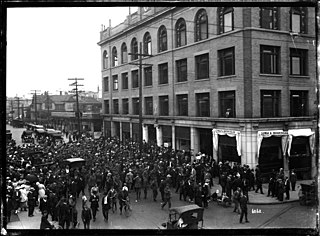The degree of labour market flexibility is the speed with which labour markets adapt to fluctuations and changes in society, the economy or production. This entails enabling labour markets to reach a continuous equilibrium determined by the intersection of the demand and supply curves. [1] [2]
Labour unions can limit labor market flexibility by negotiating higher wages, benefits, and better working conditions with employers. In the words of Siebert, [3] labour unions were seen to inhibit "the clearing functions of the market by weakening the demand for labor, making it less attractive to hire a worker by explicitly pushing up the wage costs or by introducing a negative shadow price for labor; by distorting the labor supply; and by impairing the equilibrating function of the market mechanism (for instance, by influencing bargaining behavior)." [4]
The most well-known concept of labour market flexibility is given by Atkinson. [5] Based on the strategies companies use, he notes that there can be four types of flexibility.
External numerical flexibility is the adjustment of the labour intake, or the number of workers from the external market. This can be achieved by employing workers on temporary work or fixed-term contracts or through relaxed hiring and firing regulations or in other words relaxation of employment protection legislation, where employers can hire and fire permanent employees according to the firms' needs. Employers typically prefer high levels of unemployment because, as workers become more desperate for employment, they are willing to work for lower wages, thus increasing employer profits.
Internal numerical flexibility, sometimes known as working time flexibility or temporal flexibility, is achieved by adjusting working hours or schedules of workers already employed within the firm. This includes part-time, flexi time or flexible working hours or shifts (including night shifts and weekend shifts), working time accounts, leaves such as parental leave, and overtime. Many employers thus hire large numbers of part-time employees to avoid government regulations associated with full-time employees, such as the requirement that employers pay for health insurance of their full-time employees. This allows employers to maximize their own profits while decreasing the standard of living of the working classes.
Functional flexibility or organizational flexibility is the extent to which employees can be transferred to different activities and tasks within the firm. It has to do with organization of operation or management and training workers. This can also be achieved by outsourcing activities. Job rotation is a label given to many functional flexibility schemes.
Financial or wage flexibility occurs when wage levels are not decided collectively and there are more differences between the wages of workers. This is done so that pay and other employment costs reflect the supply and demand of labour and so that employers can force employees to compete for wages, thus lowering the average wage paid to employees and ultimately to maximize profits while decreasing the standard of living of the working classes. This can be achieved by rate-for-the-job systems, or assessment based pay system, or individual performance wages.
Labour market flexibility refers to more than the strategies used by employers to adapt to their production or business cycles as it is in the definitions above. Increasingly, the common view is that labour market flexibility can potentially be used for both workers and companies, or employees and employers. [6] It can also be used as a method to enable workers to "adjust working life and working hours to their own preferences and to other activities". [7] As companies adapt to business cycles and facilitate their needs through the use of labour market flexibility strategies, workers adapt their life cycles and their needs through it (Chung, 2006).
The European Commission also addresses this issue in its Joint Employment Report and its new Flexicurity approach, calling for an adequate method to enhance flexibility for both workers and employers that is "capable of quickly and effectively mastering new productive needs and skills and about facilitating the combination of work and private responsibilities." [8] ETUC also emphasizes the importance of the development of working time flexibility as an alternative to implementing external flexibility as the sole method of increasing flexibility in the labour market (ETUC, 2007).
In their report on working time, the TUC has also argued that flexible working should be extended to all workers through stronger regulations (Fagen et al. for TUC, 2006). As authors Gerson and Jacobs agree, "flexibility and autonomy are only useful if workers feel able to use them" (Gerson & Jacobs, 2004, pg. 238). [9]
Some of the widely used arrangements that enable workers more flexibility in their work include flextime, remote work, and part-time jobs.
{{cite web}}: CS1 maint: archived copy as title (link)
Labour economics, or labor economics, seeks to understand the functioning and dynamics of the markets for wage labour. Labour is a commodity that is supplied by labourers, usually in exchange for a wage paid by demanding firms. Because these labourers exist as parts of a social, institutional, or political system, labour economics must also account for social, cultural and political variables.
Labour laws are those that mediate the relationship between workers, employing entities, trade unions, and the government. Collective labour law relates to the tripartite relationship between employee, employer, and union.
A minimum wage is the lowest remuneration that employers can legally pay their employees—the price floor below which employees may not sell their labor. Most countries had introduced minimum wage legislation by the end of the 20th century. Because minimum wages increase the cost of labor, companies often try to avoid minimum wage laws by using gig workers, by moving labor to locations with lower or nonexistent minimum wages, or by automating job functions. Minimum wage policies can vary significantly between countries or even within a country, with different regions, sectors, or age groups having their own minimum wage rates. These variations are often influenced by factors such as the cost of living, regional economic conditions, and industry-specific factors.
Collective bargaining is a process of negotiation between employers and a group of employees aimed at agreements to regulate working salaries, working conditions, benefits, and other aspects of workers' compensation and rights for workers. The interests of the employees are commonly presented by representatives of a trade union to which the employees belong. A collective agreement reached by these negotiations functions as a labour contract between an employer and one or more unions, and typically establishes terms regarding wage scales, working hours, training, health and safety, overtime, grievance mechanisms, and rights to participate in workplace or company affairs. Such agreements can also include 'productivity bargaining' in which workers agree to changes to working practices in return for higher pay or greater job security.
Employment is a relationship between two parties regulating the provision of paid labour services. Usually based on a contract, one party, the employer, which might be a corporation, a not-for-profit organization, a co-operative, or any other entity, pays the other, the employee, in return for carrying out assigned work. Employees work in return for wages, which can be paid on the basis of an hourly rate, by piecework or an annual salary, depending on the type of work an employee does, the prevailing conditions of the sector and the bargaining power between the parties. Employees in some sectors may receive gratuities, bonus payments or stock options. In some types of employment, employees may receive benefits in addition to payment. Benefits may include health insurance, housing, disability insurance. Employment is typically governed by employment laws, organisation or legal contracts.

A wage is payment made by an employer to an employee for work done in a specific period of time. Some examples of wage payments include compensatory payments such as minimum wage, prevailing wage, and yearly bonuses, and remunerative payments such as prizes and tip payouts. Wages are part of the expenses that are involved in running a business. It is an obligation to the employee regardless of the profitability of the company.

Temporary work or temporary employment refers to an employment situation where the working arrangement is limited to a certain period of time based on the needs of the employing organization. Temporary employees are sometimes called "contractual", "seasonal", "interim", "casual staff", "outsourcing", "freelance"; or the words may be shortened to "temps". In some instances, temporary, highly skilled professionals refer to themselves as consultants. Increasingly, executive-level positions are also filled with interim executives or fractional executives.

A living wage is defined as the minimum income necessary for a worker to meet their basic needs. This is not the same as a subsistence wage, which refers to a biological minimum, or a solidarity wage, which refers to a minimum wage tracking labor productivity. Needs are defined to include food, housing, and other essential needs such as clothing. The goal of a living wage is to allow a worker to afford a basic but decent standard of living through employment without government subsidies. Due to the flexible nature of the term "needs", there is not one universally accepted measure of what a living wage is and as such it varies by location and household type. A related concept is that of a family wage – one sufficient to not only support oneself, but also to raise a family.
Flextime is a flexible hours schedule that allows workers to alter their workday and decide/adjust their start and finish times. In contrast to traditional work arrangements that require employees to work a standard 9 a.m. to 5 p.m. day, flextime typically involves a "core" period of the day during which employees are required to be at work, and a "bandwidth" period within which all required hours must be worked. The working day outside of the "core" period is "flexible time", in which employees can choose when they work, subject to achieving total daily, weekly or monthly hours within the "bandwidth" period set by employers, and subject to the necessary work being done. The total working time required of employees on flextime schedules is the same as that required under traditional work schedules.
The term efficiency wages was introduced by Alfred Marshall to denote the wage per efficiency unit of labor. Marshallian efficiency wages would make employers pay different wages to workers who are of different efficiencies such that the employer would be indifferent between more-efficient workers and less-efficient workers. The modern use of the term is quite different and refers to the idea that higher wages may increase the efficiency of the workers by various channels, making it worthwhile for the employers to offer wages that exceed a market-clearing level. Optimal efficiency wage is achieved when the marginal cost of an increase in wages is equal to the marginal benefit of improved productivity to an employer.
Labour power is the capacity to do work, a key concept used by Karl Marx in his critique of capitalist political economy. Marx distinguished between the capacity to do work, labour power, and the physical act of working, labour. Labour power exists in any kind of society, but on what terms it is traded or combined with means of production to produce goods and services has historically varied greatly.

The European Trade Union Confederation (ETUC) is the major trade union organisation representing workers at the European level. In its role as a European social partner, the ETUC works both in a consulting role with the European Commission and negotiates agreements and work programmes with European employers. It coordinates the national and sectoral policies of its affiliates on social and economic matters, particularly in the framework of the EU institutional processes, including European economic governance and the EU Semester.
Flexicurity is a welfare state model with a pro-active labour market policy. The term was first coined by the social democratic Prime Minister of Denmark Poul Nyrup Rasmussen in the 1990s.
Employment discrimination is a form of illegal discrimination in the workplace based on legally protected characteristics. In the U.S., federal anti-discrimination law prohibits discrimination by employers against employees based on age, race, gender, sex, religion, national origin, and physical or mental disability. State and local laws often protect additional characteristics such as marital status, veteran status and caregiver/familial status. Earnings differentials or occupational differentiation—where differences in pay come from differences in qualifications or responsibilities—should not be confused with employment discrimination. Discrimination can be intended and involve disparate treatment of a group or be unintended, yet create disparate impact for a group.

Labor relations is a field of study that can have different meanings depending on the context in which it is used. In an international context, it is a subfield of labor history that studies the human relations with regard to work in its broadest sense and how this connects to questions of social inequality. It explicitly encompasses unregulated, historical, and non-Western forms of labor. Here, labor relations define "for or with whom one works and under what rules. These rules determine the type of work, type and amount of remuneration, working hours, degrees of physical and psychological strain, as well as the degree of freedom and autonomy associated with the work." More specifically in a North American and strictly modern context, labor relations is the study and practice of managing unionized employment situations. In academia, labor relations is frequently a sub-area within industrial relations, though scholars from many disciplines including economics, sociology, history, law, and political science also study labor unions and labor movements. In practice, labor relations is frequently a subarea within human resource management. Courses in labor relations typically cover labor history, labor law, union organizing, bargaining, contract administration, and important contemporary topics.
In economics, a monopsony is a market structure in which a single buyer substantially controls the market as the major purchaser of goods and services offered by many would-be sellers. The microeconomic theory of monopsony assumes a single entity to have market power over all sellers as the only purchaser of a good or service. This is a similar power to that of a monopolist, which can influence the price for its buyers in a monopoly, where multiple buyers have only one seller of a good or service available to purchase from.

The Wage and Hour Division (WHD) of the United States Department of Labor is the federal office responsible for enforcing federal labor laws. The Division was formed with the enactment of the Fair Labor Standards Act of 1938. The Wage and Hour mission is to promote and achieve compliance with labor standards to protect and enhance the welfare of the Nation's workforce. WHD protects over 144 million workers in more than 9.8 million establishments throughout the United States and its territories. The Wage and Hour Division enforces over 13 laws, most notably the Fair Labor Standards Act and the Family Medical Leave Act. In FY18, WHD recovered $304,000,000 in back wages for over 240,000 workers and followed up FY19, with a record-breaking $322,000,000 for over 300,000 workers.
The Labor policy in the Philippines is specified mainly by the country's Labor Code of the Philippines and through other labor laws. They cover 38 million Filipinos who belong to the labor force and to some extent, as well as overseas workers. They aim to address Filipino workers’ legal rights and their limitations with regard to the hiring process, working conditions, benefits, policymaking on labor within the company, activities, and relations with employees.
The National Trades Union Congress (NTUC) spearheads the labour movement of Singapore, which represents almost a million workers in the country across more than 70 unions, affiliated associations and related organisations. Singapore runs on a tripartism model which aims to offers competitive advantages for the country by promoting economic competitiveness, harmonious government-labour-management relations and the overall progress of the nation.
Dispatched labor refers to an atypical employment relationship. Dispatch work agencies receive requests from businesses to have them hire and manage labor on the business' behalf. This type of labor is known as "dispatched labor". There is in fact no direct contract between dispatched laborers and the enterprise which uses the agency's services, so in this way, dispatched employment follows a triangle structure. As dispatch agencies are often highly adept in hiring and managing workforces, businesses are more than happy to use an agency to manage part of their workforce as it saves time, money, and if you are a foreign enterprise, the hassle of quickly understanding the legal workings of a local labor force.